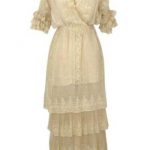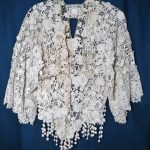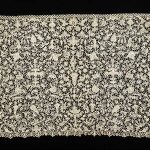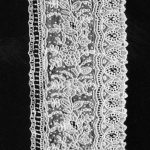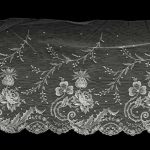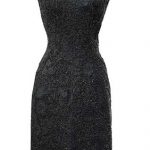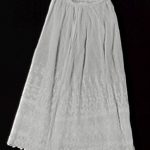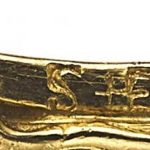Lace is a delicate fabric made of yarn or thread in an openwork pattern, made by machine or by hand. Originally linen, silk, gold, or silver threads were used but is often made with cotton thread, although linen and silk threads are still available. Manufactured lace may be made of synthetic fiber. A few modern artists make it with a fine copper or silver wire instead of thread.
It’s origin is disputed by historians. An Italian claim is a will of 1493 by the Milanese Sforza family. A Flemish claim is lace on the alb of a worshiping priest in a painting about 1485 by Hans Memling. But since it evolved from other techniques, it is impossible to say that it originated in any one place.
The late 16th century marked the rapid development of lace, both needle lace and bobbin lace became dominant in both fashion as well as home décor. For enhancing the beauty of collars and cuffs, needle lace was embroidered with loops and picots.
Lace was used by clergy of the early Catholic Church as part of vestments in religious ceremonies but did not come into widespread use until the 16th century in the northwestern part of the European continent. The popularity of lace increased rapidly and the cottage industry of lace making spread throughout Europe. In 1840, Britain’s Queen Victoria was married in lace, influencing the wedding dress style until now. In North America in the 19th century, missionaries spread the knowledge of lace making to the Native American tribes. St. John Francis Regis guided many women out of prostitution by establishing them in the lace making and embroidery trade, which is why he became the Patron Saint of lace making.
The English diarist Samuel Pepys often wrote about the lace used for his, his wife’s, and his acquaintances’ clothing, and on 10 May 1669, noted that he intended to remove the gold lace from the sleeves of his coat “as it is fit [he] should”, possibly in order to avoid charges of ostentatious living.
Catherine of Aragon while exiled in Ampthill, England, was said to have supported the lace makers there by burning all her lace, and commissioning new pieces. This may be the origin of the lacemaker’s holiday – Cattern’s day. On this day (25 or 26 November) lacemakers were given a day off from work, and Cattern cakes – small dough cakes made with caraway seeds, were used to celebrate. Reference: Wikipedia
Alice Maynard Lace Dress American, circa 1913 Of off-white lawn and embroidered net panels with point d’esprit, the empire bodice crossover and trimmed in lace ruffle, tulle modesty panel, modified short gusseted dolman sleeves concluding in triple tiered Valencienne lace ruffled cuff, tulle underskirt with three tiered lace ruffle at hem, tunic overskirt hemmed in lace, size 4, labeled: Alice Maynard/New York and Washington DC. Excellent condition, age discoloration.
Sold for $540 (includes buyer’s premium) at Doyle New York in 2006
Victorian Era Flower Lace Shawl
Amazing flower lace shawl. Great detailed, open front shawl., these are approximate measurements: Shoulder: 20″Bust: 17″Sleeve: 13.5″Length: 24″ at longest point
Sold for $500 at Appraisal & Estate Sale Specialists, Inc. in 2018
Lace fourth quarter 17th century French This is an exquisitely crafted needle lace cravat end. Lace was often utilized as neckwear in the 17th and 18th centuries for aesthetic purposes and to emphasize the fine quality the wearer could afford. This particular piece is finely detailed with mirror-image motifs which take no identifiable shape but are nevertheless intriguing. The addition of the raised work adds a sense of depth and texture to already arresting surface effect.
Reference: The Metropolitan Museum of Art
Brussel lace border, needle lace technique, probably cotton, Brussels, Belgium, 1850-1900 Made by in Brussels, Belgium, 1850-1900. Brussel lace border, needle lace technique, probably cotton, Brussels, Belgium, 1850-1900 Brussels lace border, needle lace technique, probably made of cotton. Border features a shallow headside with vertical open petalled flowers joined at the base to a scalloped banded ribbon. Continuous floral bouquets worked in a fine spotted hexagonal mesh ground form central body of the border, footside with continouus elongated oval motifs. Applied needle lace engrelure. The pattern repeat is 90mm in width. The solid areas of the dsign are worked in simple corded buttonhole stitch,either “closed” or “open” to suggest light and shade.The cordonnet is a group of threads loosely buttonholed over the foundation cord as in Diagram 1. Where the cordonnet is part of the headside edge it isgenerally decorated with a rown of triple-twisted buttonhole stitches. Border is probably made using the needle lace technique and is probably made of cotton.
Reference: Museum of Applied Art and Sciences
Lace border European early 20th century
Ecru lace border with delicate stylized floral motifs along outside edge.
Reference: Museum of Fine Arts Boston
MINGOLINI GUGENHEIM, HAUTE COUTURE, CIRCA 1959 A short black lace sheath dress with pearl embroidery Claudia Cardinale wore this dress in the movie I delfini by Francesco Maselli, released in 1960. A photograph of a movie’s sequence is illustrated in L’Aurore of September 2nd 1960. She also wore this model at the Villa Giulia in Roma the same year, then in April 12th, 1965 to receive the Nastro d’Argento of the best actress in La Ragazza di Bube, with Rock Hudson.
Sold for 3,500 EUR at Sotheby’s in 2019
[geolocator_show for=”GB”][ebayfeedsforwordpress feed=”http://rest.ebay.com/epn/v1/find/item.rss?keyword=lace&categoryId1=181677&categoryId2=175759&sortOrder=BestMatch&programid=15&campaignid=5338620288&toolid=10039&customid=pastimefashions-rss-uk-lace&minPrice=70.0&listingType1=All&feedType=rss&lgeo=1″ items=”20″][/geolocator_show]
[geolocator_hide for=”GB”][ebayfeedsforwordpress feed=”http://rest.ebay.com/epn/v1/find/item.rss?keyword=lace&categoryId1=181677&categoryId2=175759&sortOrder=BestMatch&programid=1&campaignid=5338620289&toolid=10039&customid=pastimefashions-rss-us-lace&minPrice=70.0&listingType1=All&feedType=rss&lgeo=1″ items=”20″][/geolocator_hide]
